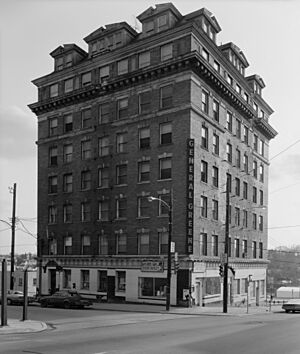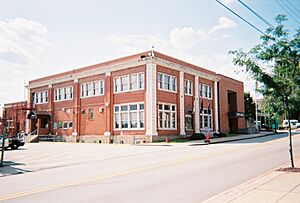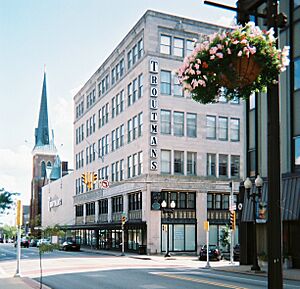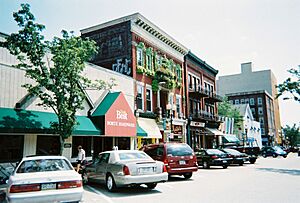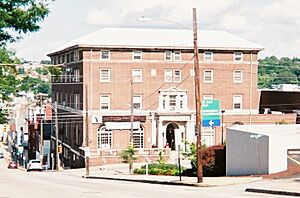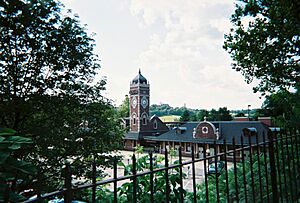Greensburg, Pennsylvania facts for kids
Quick facts for kids
Greensburg, Pennsylvania
|
|||
|---|---|---|---|
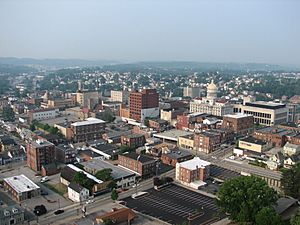
Downtown Greensburg
|
|||
|
|||
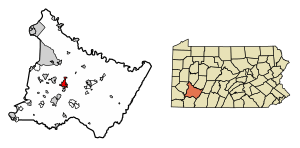
Location of Greensburg in Westmoreland County, Pennsylvania
|
|||
| Country | United States | ||
| State | Pennsylvania | ||
| County | Westmoreland | ||
| Incorporated | February 9, 1799 | ||
| Named for | Nathanael Greene | ||
| Government | |||
| • Type | Mayor-Council | ||
| • Body | Greensburg City Council | ||
| Area | |||
| • Total | 4.05 sq mi (10.50 km2) | ||
| • Land | 4.05 sq mi (10.50 km2) | ||
| • Water | 0.00 sq mi (0.00 km2) | ||
| Elevation | 1,017 ft (310 m) | ||
| Population
(2020)
|
|||
| • Total | 14,976 | ||
| • Density | 3,693.22/sq mi (1,425.80/km2) | ||
| • Demonym | Greensburger | ||
| Time zone | UTC−5 (EST) | ||
| • Summer (DST) | UTC−4 (EDT) | ||
| ZIP codes |
15601, 15605, 15606
|
||
| Area code(s) | 724, 878 | ||
| FIPS code | 42-31200 | ||
| GNIS feature ID | 1215700 | ||
| Website | www.greensburgpa.org | ||
Greensburg is a city in and the county seat of Westmoreland County, Pennsylvania, United States. The population was 14,976 at the 2020 census. Located 30 miles (48 km) southeast of Pittsburgh, Greensburg is a part of the Pittsburgh metropolitan area. The city lies within the Laurel Highlands and the ecoregion of the Western Allegheny Plateau. The city is named after Nathanael Greene, a major general of the Continental Army in the American Revolutionary War.
Contents
History
After the end of the Revolutionary War, an inn was built along a wagon trail that stretched from Philadelphia west over the Appalachian Mountains to Fort Pitt, now the city of Pittsburgh. A tiny settlement known as Newtown grew around the inn, which is today the center of Greensburg's Business District at the intersection of Pittsburgh and Main Streets. At Pittsburgh, the wagon trail became Penn Avenue.
Hannastown was the original Westmoreland County seat. According to historian John Boucher, after Hannastown was attacked and burned by "Indians and Tories" in 1782, efforts began to relocate the county seat. On December 10, 1785, county officials contracted with Christopher Truby and William Jack to purchase two acres of Newtown land to erect public buildings. Ludwick Otterman later subscribed to the agreement. Boucher, therefore, designates December 10, 1785, as the date Newtown became the Westmoreland County seat.
The first courthouse and jail were a single building built of logs and heavy planks. The jail portion had a heavy stone wall that extended some distance above the ground, "perhaps to keep prisoners from cutting their way out". Court was first held in this structure on January 7, 1787. The Westmoreland County Courthouse, in its various incarnations, has stood on this site ever since. The area surrounding the courthouse became Greensburg ("Greenesburgh", as some documents referred to it at the time). It was named for American Revolutionary War General Nathanael Greene. Greensburg was formally incorporated as a borough on February 9, 1799, making it the first borough in the county.
In the early 19th century, Greensburg had very little population growth (see population data table in this article). After 1850, Greensburg became a growing county seat with inns and small businesses. A railroad stop and the discovery of large areas of soft coal nearby made it the center of a vigorous mining industry in the late 19th century and early 20th century. Several coal mines (Greensburg/Keystone Nos. 1 and 2, Hawksworth, and Radebaugh) were opened in and around Greensburg during this period with nearly all of the coal being shipped by rail.
Seton Hill College, formerly St. Joseph's Academy, became a four-year women's institution in 1918. Greensburg became a City of the Third Class on January 2, 1928. After World War II, more residential areas were developed in various sections of town. Greensburg's cultural status grew as the Westmoreland County Museum of Art opened in 1959 and the University of Pittsburgh founded the branch campus, the University of Pittsburgh at Greensburg, in 1963, now located in Hempfield Township.
The opening of Greengate Mall and Westmoreland Mall in 1965 and 1977, respectively, marked a new era for retail shopping in the area but negatively impacted retail businesses in Downtown Greensburg's shopping district. Changes in local shopping habits had already taken their toll by the late 1970s when Troutman's Department Store closed. By the mid-1990s, city officials shifted their revitalization plans on the cultural aspects of Downtown Greensburg, such as the restorations of the Palace Theater and the historic Train Station, as well as a performing arts center for Seton Hill University. Also, in July 2009, Lake Erie College of Osteopathic Medicine, the largest medical school in the country, opened a satellite campus at Seton Hill University. Now, over 200 students study at LECOM at Seton Hill every year. As part of this ongoing transition, an expansion of the Westmoreland Museum of American Art was completed in 2015.
The city is home to the Diocese of Greensburg.
Neighborhoods
The city of Greensburg is currently composed of eight wards, most of which were formerly boroughs and are divided into several neighborhoods. Bunker Hill, now Fifth Ward, was merged into Greensburg in 1894. The name originated because of fights at the rowdy Bushfield Tavern in the early 1840s to mid-19th century that were compared to the Battle of Bunker Hill.
In 1905, Greensburg absorbed three adjacent boroughs, including Ludwick, now Sixth Ward, which was named for Ludwick Otterman, an early settler for whom the street is also named, as well as East Greensburg, now Seventh Ward, and Southeast Greensburg, unofficially known as Paradise (Eighth Ward). South Maple Avenue was originally named Kinderhook (Third Ward). Second Ward, located north of Downtown Greensburg, is the largest ward and includes the neighborhoods of Saybrook Village, Evergreen Hill, New Salem Acres, Country Club Meadows, Northmont, Devonshire Heights, Rose Fountain Farms, and Academy Hill. Hilltop, a neighborhood in Eighth Ward, was originally settled by Italian immigrants and borders South Greensburg and Underwood on either side. First Ward features Chestnut Hill and Shuey Plan and is also home to Seton Hill University. Other Greensburg neighborhoods include Eastern Estates, Underwood, Shogan, and Hillcrest.
Eighth Ward was originally home to many Italian immigrants from Cercemaggiore, Italy. Today, the original Our Lady of Grace Church, built by the masons from Italy, still stands although used as a residence. The Hilltop Social Club, founded by a few families who lived in the areas of Bierer, Margaret, White, and Catherine Streets, is also located here. Every year it has become a tradition for the firehall in the Eighth Ward to throw a carnival which includes bingo, amusement rides, and the locally-known Shuey Burgers, a relatively simple combination of a freshly grilled hamburger and fried, caramelized Vidalia onions.
Two neighborhoods have been designated as U.S. historic districts, the Greensburg Downtown Historic District and the Academy Hill Historic District. Also listed on the National Register of Historic Places are the Greensburg Railroad Station and Westmoreland County Courthouse.
Demographics
| Historical population | |||
|---|---|---|---|
| Census | Pop. | %± | |
| 1810 | 685 | — | |
| 1820 | 771 | 12.6% | |
| 1830 | 810 | 5.1% | |
| 1840 | 800 | −1.2% | |
| 1850 | 1,051 | 31.4% | |
| 1860 | 1,388 | 32.1% | |
| 1870 | 1,642 | 18.3% | |
| 1880 | 2,500 | 52.3% | |
| 1890 | 4,202 | 68.1% | |
| 1900 | 6,508 | 54.9% | |
| 1910 | 13,012 | 99.9% | |
| 1920 | 15,033 | 15.5% | |
| 1930 | 16,508 | 9.8% | |
| 1940 | 16,743 | 1.4% | |
| 1950 | 16,923 | 1.1% | |
| 1960 | 17,383 | 2.7% | |
| 1970 | 17,077 | −1.8% | |
| 1980 | 17,588 | 3.0% | |
| 1990 | 16,318 | −7.2% | |
| 2000 | 15,899 | −2.6% | |
| 2010 | 14,892 | −6.3% | |
| 2020 | 14,976 | 0.6% | |
| Sources: | |||
As of the census of 2000, there were 15,889 people, 7,144 households, and 3,922 families residing in the city. The population density was 3,746.1 inhabitants per square mile (1,446.4/km2). There were 7,734 housing units at an average density of 1,823.4 per square mile (704.0/km2). The racial makeup of the city was 93.43% White, 3.91% African American, 0.09% Native American, 0.70% Asian, 0.01% Pacific Islander, 0.38% from other races, and 1.47% from two or more races. Hispanic or Latino of any race were 1.08% of the population.
There were 7,144 households, out of which 24.1% had children under the age of 18 living with them, 39.3% were married couples living together, 12.8% had a female householder with no husband present, and 45.1% were non-families. 39.2% of all households were made up of individuals, and 15.4% had someone living alone who was 65 years of age or older. The average household size was 2.11, and the average family size was 2.85.
In the city, the age distribution of the population shows 20.2% under the age of 18, 10.0% from 18 to 24, 27.9% from 25 to 44, 22.6% from 45 to 64, and 19.3% who were 65 years of age or older. The median age was 39 years. For every 100 females, there were 81.7 males. For every 100 females age 18 and over, there were 76.1 males.
The median income for a household in the city was $30,324, and the median income for a family was $41,112. Males had a median income of $33,306 versus $24,246 for females. The per capita income for the city was $18,312. About 10.8% of families and 13.6% of the population were below the poverty line, including 18.1% of those under age 18 and 11.9% of those age 65 or over.
Economy
Originally a railroad stop on the Pennsylvania Railroad, Greensburg quickly became the center of the coal mining industry in the region by the late 19th century when large areas of soft coal were discovered nearby. This contributed to the growth and development of the growing county seat. Many businesses and inns flourished within Downtown Greensburg for many years and once boasted four major department stores – JCPenney, Royers, Sears and its largest department store, Troutman's.
In August 1965, Greengate Mall opened west of the city in Hempfield Township. Greengate was part of the first wave of indoor shopping malls in the country. The mall's opening marked a new era for retail shopping in the area. However, it negatively impacted stand-alone businesses in Greensburg's downtown corridor. By the late 1970s, several local stores, including Troutman's, the city's major department store, closed. The downtown area eventually rebounded as the city became a center for service industries, professional offices, and banking. Today, small downtown shops and a growing number of restaurants are reviving downtown as a mercantile center.
Westmoreland Mall and the attached Live! Casino Pittsburgh is the largest shopping and entertainment complex in the Greensburg area and Westmoreland County. Greengate Mall suffered losses in the 1990s when anchor store JCPenney relocated to Westmoreland Mall. As the mall continued on its irreversible decline, the nationally based Montgomery Ward and the regional chain Horne's also closed. The building was eventually razed in 2003, and a new shopping center called Greengate Centre, anchored by a Walmart, was subsequently built. Numerous shopping plazas and dining establishments also line the Route 30 corridor east and west of the city. With over 5,000,000 square feet (460,000 m2) of retail space and growing, Greensburg is considered the commercial center of the Laurel Highlands region of Pennsylvania as well as one of the largest retail markets in Western Pennsylvania.
Light to moderate industry and service industries thrive in the Greater Greensburg area. Several industrial parks are primarily located outside the city limits. Housing growth continues on the city's northern end, with the Saybrook Village and Evergreen Hill plans.
Major employers
Three major corporations are headquartered in the Greensburg area: Excela Health, Hillandale Farms and the Tribune-Review. Nearly 300 employees of the Pennsylvania Department of Labor and Industry work in the State Office Building on North Main Street.
Arts and culture
Greensburg is a major cultural center in Western Pennsylvania. It is the home of the Westmoreland Museum of American Art, which specializes in American Art circa 1750–1950. In the heart of the city's emerging cultural district, the Palace Theatre is the site for various performances throughout the year. Additionally, it is the home of the Westmoreland Symphony Orchestra and the Summer Sounds Concert Series at the Robertshaw Amphitheater in St. Clair Park.
The Westmoreland Cultural Trust has played a major role in the revitalization of Downtown Greensburg in recent years. Its accomplishments include the renovation of the Palace Theatre and the Train Station. They are also responsible for renovating several commercial buildings in the downtown area. Stage Right! also contributes to the region's culture, offering classes in musical theatre for young people and staging professional productions at the Palace Theater and Greensburg Garden and Civic Center. Greensburg Civic Theatre, one of the few long-established volunteer-based community theatre organizations in Westmoreland County, has been presenting both adult and children's theater productions for over 60 years. Founded in 1951, they are the resident theatre company at the Greensburg Garden and Civic Center. The Performance Arts Center of Seton Hill University opened its doors to the public in September 2009. This multimillion-dollar complex, located in the city's Cultural District, is expected to serve as an additional catalyst for the future growth of the downtown core.
A hands-on science center, to feature a wide range of interactive exhibits, was proposed for the former Mellon Bank building downtown. However, it has since been put on hold indefinitely. The Discovery & Interactive Science Center (DISC) would have been a regional attraction for Westmoreland, Fayette, Indiana, Somerset, and Bedford counties. It would have also been the only interactive science center between the Carnegie Science Center in Pittsburgh and the Harsco Science Center in Harrisburg.
The World Conference Center for The Church of Jesus Christ is located west of Greensburg on PA Route 136. It is the third-largest branch of the Latter Day Saint movement. The national headquarters of the Kappa Delta Rho fraternity is in Greensburg. The Saint Emma Monastery (founded 1931) is a Catholic retreat house and monastery for the Sisters of Saint Benedict located in Greensburg.
Education
Public schools
The Greater Greensburg area contains two public school districts. The larger of the two is the Hempfield Area School District. The school district has a resident population of over 50,000, spans approximately ninety-five square miles, and lies thirty miles southeast of Pittsburgh. Comprising Hempfield Township, and the communities of Adamsburg, Armbrust, Bovard, Grapeville, Hannastown, Hunker, Luxor, Manor, New Stanton, and Youngwood, the school district completely surrounds the city of Greensburg. Hempfield is also the largest school district in Westmoreland County, with approximately 7,000 enrolled students and one of Western Pennsylvania's largest.
The second school district servicing Greensburg is the Greensburg Salem School District. The school district covers an area of fifty-one square miles. With an enrollment of 3,600 students, Greensburg Salem serves the City of Greensburg, South Greensburg, Southwest Greensburg and Salem Township.
Private schools
Greensburg is home to Greensburg Central Catholic High School and Aquinas Academy (www.aquinasacademy.org), both private Catholic schools.
Colleges and universities
The immediate vicinity of Greensburg contains two universities – Seton Hill University and the University of Pittsburgh at Greensburg. Seton Hill University was founded in 1885 by the Sisters of Charity on a bluff overlooking the City of Greensburg. Formerly a women's college, Seton Hill became a coeducational university in 2002. In recent years, Seton Hill has begun to expand into the downtown area by constructing several academic buildings and a performing arts center. The Greensburg campus of the University of Pittsburgh was founded in 1963 in Downtown Greensburg. It would later grow into a large campus in nearby Hempfield Township. It was voted "Best University in the Region" for eight straight years (1999–2007) by the Tribune-Review. In addition, the branches of Carlow University, Lake Erie College of Osteopathic Medicine and Triangle Tech are located within the Greater Greensburg area.
The campuses of Saint Vincent College and Westmoreland County Community College are also located in the nearby communities of Latrobe and Youngwood, respectively.
Libraries
The Greensburg Hempfield Area Library serves the City of Greensburg and Hempfield Township.
Media
Greensburg, the county seat of Westmoreland County, is located close (approximately 30 miles southeast) to the city of Pittsburgh in Allegheny County and receives radio and television stations that are based out of the larger city, Pittsburgh. Locally though, Greensburg and its surrounding area are served by several local radio stations licensed to various nearby Westmoreland County communities.
- Most of the local Westmoreland County radio stations serving the Greensburg area are owned by Broadcast Communications, Inc. (BCI). BCI is locally owned and operated by Greensburg, PA residents, Robert and Ashley Stevens. These local BCI stations include 103.1 WKVE (album-oriented rock), 103.9 WKHB-FM (adult contemporary), 97.5 770 WKFB (oldies), and 92.3 620 WKHB (variety including talk, classic hits, ethnic, and ministry), which originally was WHJB commencing broadcasting on October 28 in 1934 as Westmoreland County's first radio station, broadcasting and actually transmitting (during its early years) with a roof-mounted antenna system from the Penn Albert Hotel in downtown Greensburg but modifying the call sign to WKHB circa 2000 when the station upgraded its facilities to cover a much broader regional southwestern Pennsylvania area.
- Renda Broadcasting also serves the Greensburg area with 107.1 WHJB (classic hits). It was originally a sister station to 620 WKHB when 620 was WHJB. The 107.1 frequency has had various call signs and formats over the years, including WHJB-FM, WOKU, WSSZ (Z107), WPNT, WJJJ and WGSM (Sam FM). The station finally adopted the call sign WHJB circa 2010.
- To a much lesser degree, the translator 98.7 W254CR, which rebroadcasts the programming of 910 WXJX-AM Apollo, Armstrong County, also provides radio service with an adult hits music format known as "Jack FM", which was launched on December 31, 2018.
- Greensburg's major newspaper is the Tribune-Review, owned by the Tribune-Review Publishing Company. In 1992, this company founded the Pittsburgh Tribune Review, a competitor to the Pittsburgh Post-Gazette. This occurred immediately following the demise of the Pittsburgh Press. The Tribune-Review Publishing Company was owned by a noted philanthropist and conservative figure Richard Mellon Scaife. Since starting the Pittsburgh Tribune Review, the original Tribune-Review that circulates in and around Greensburg has upgraded its national and international news coverage but continues to maintain a robust local news section. The Pittsburgh edition closed in 2016. The Greensburg edition remains.
- LCS Hockey, a newsletter turned internationally renowned website, was founded in Greensburg.
- In 2004, Greensburg attorney P. Louis DeRose published the book, Greensburg through the Arcadia Publishing Images of America Series.
- In 2006, Greensburg resident Rachel E. Smith published the book, Greensburg through the Arcadia Publishing Postcard History Series.
Greensburg in fiction
- Mystery novel writer K. C. Constantine has used various elements of Greensburg as a basis for the fictional town of Rocksburg in his novels.
Professional sports
American football
From 1890 until 1900, Greensburg was the home of the Greensburg Athletic Association, one of the earliest professional football teams. The team began as an amateur football club in 1890 and was composed primarily of locals before several paid players were added for 1895. In 1894 it was discovered that the team had secretly paid formerly Indiana Normal (now Indiana University of Pennsylvania) player, Lawson Fiscus, to play football and retained his services on salary. The team was the chief rival of another early professional football team, the Latrobe Athletic Association.
On December 3, 1898, two players from the Greensburg Athletic Association joined with the Latrobe Athletic Association to form the very first professional football all-star team for a game against the Duquesne Country and Athletic Club, to be played at Pittsburgh's Exposition Park. Duquesne went on to win the game 16–0.
Aside from Fiscus, the Greensburg Athletic Association included several of the era's top players, such as: Charlie Atherton, George Barclay, Ross Fiscus, Jack Gass, Arthur McFarland, Charles Rinehart, Isaac Seneca and Adam Martin Wyant. Several of these players revolutionized the game during their playing careers. Charlie Atherton is credited with inventing the place kick, and George Barclay invented the first-ever football helmet. Meanwhile, Isaac Seneca became the first Native-American to earn All-American honors and Adam Wyant made history by becoming the first professional football player to be elected to the United States Congress.
Baseball
In 1907, Greensburg fielded the Greensburg Red Sox, a Minor League Baseball team in the Class D Western Pennsylvania League that played for one season in 1907. Then from 1934 until 1939, Greensburg was also the home of the Greensburg Red Wings, a Class D Minor League Baseball team was affiliated with the St. Louis Cardinals, Brooklyn Dodgers and Washington Senators. The team's name changed several times over the years. In 1934, the team was founded as the Greensburg Trojans. A year later, they took on the Red Wings moniker. By 1937, the team was renamed the Greensburg Green Sox and finally the Greensburg Senators in 1939.
Transportation
Highways
The east-west U.S. Route 30 expressway bypasses Greensburg to the south, as does the north–south Pennsylvania Turnpike 66 to the west. A proposed highway called the Laurel Valley Expressway was initially planned to be built to the east of Greensburg, primarily in Unity, Derry, and Mount Pleasant townships, but that project has never materialized. The Pennsylvania Turnpike's New Stanton exit is approximately six miles (9 km) south of Greensburg on U.S. Route 119 where Interstate 70 splits from Interstate 76. The Turnpike's Irwin exit is seven miles west of the city on U.S. Route 30. PA Routes 66 and 136 begin in Greensburg. PA Routes 130, 819, and U.S. Route 119 pass through the city. U.S. Route 22, a major connector from Central to Southwestern Pennsylvania, runs approximately seven miles north of the city through Salem Township, accessible by routes 66, 819, and 119.
Public transportation
Westmoreland Transit is the mass transit system of Greensburg and Westmoreland County. It operates bus routes seven days a week throughout the city, the county, and Pittsburgh. Greyhound Lines runs regularly scheduled bus service to and from Greensburg from many hubs, including Pittsburgh, Chicago, and New York City.
Airports
Air service is available at the Pittsburgh International Airport and the Arnold Palmer Regional Airport east of Greensburg in nearby Latrobe.
Rail
The city has Amtrak rail service at the restored Greensburg station, as well as freight rail operator Norfolk Southern and an independent shortline railroad connecting coal mines and businesses located south of the city to the Norfolk Southern line just west of Greensburg.
Bicycling
Greensburg is bike-friendly as it offers the Five Star Trail, which begins at Lynch Field and ends south of the city in Armbrust.
Infrastructure
Utilities
Electricity for Greensburg and a large portion of Westmoreland County is supplied by West Penn Power, a division of FirstEnergy. In addition, natural gas is widely used in the area due to large reserves existing throughout the region. Service is provided by Peoples Natural Gas Company and Columbia Natural Gas Company. Water utility service is provided by the Municipal Authority of Westmoreland County (MAWC). Waste collection and sewage utilities are provided by Advanced Disposal and the Greater Greensburg Sewage Authority, respectively.
Medical facilities
The Greater Greensburg area is home to several medical facilities, ranging from independent clinics and urgent care centers to full-service hospitals. The following listing is not exhaustive.
- Aestique Medical Center
- AHN Hempfield Hospital
- Bio-Medical Applications of Greensburg
- Excela Westmoreland Hospital
- Greensburg Care Center
- Innovative Health Services
- Laurel Surgical Center
- MedExpress Urgent Care Center
- West Place
Telecommunications
Greensburg is located within the 724 area code, which surrounds the 412 area code assigned to the city of Pittsburgh and most of Allegheny County, along with small portions of Washington and Westmoreland counties. In 2013, the overlay code 878 was approved for use in the area.
Notable people
- Karen Angle – ex-wife of professional wrestler Kurt Angle; current Total Nonstop Action Wrestling performer
- Carroll Baker - actress; attended Greensburg Salem High School
- Paul Bartholomew – architect of various Greensburg landmarks and designer of Norvelt, Pennsylvania
- Randy Bish – editorial cartoonist
- Scott G. Bullock – public interest lawyer who focuses on property rights issues such as eminent domain and civil forfeiture
- James Clarke – third Governor of Iowa Territory
- K.C. Constantine – mystery fiction author
- Stephen Dau – author
- Brett Detar – songwriter, musician, and record producer
- Rebecca Franklin – food writer
- Todd Gallagher – social scientist, author, filmmaker, and comedian
- Doc Gessler - Major League Baseball outfielder
- Paul Gilbert – guitarist for the bands Racer X and Mr. Big
- Jesse Root Grant – father of Union general and 18th President, Ulysses S. Grant
- Zach Jackson – Major League Baseball pitcher
- Greg Jones – highly accomplished collegiate wrestler at West Virginia University
- Sheila Kelley – actress
- Peggy King – 1950s and 1960s pop singer and television personality
- John Latta (1836-1913) - First Lieutenant Governor of Pennsylvania
- Rocco Mediate – professional golfer
- Vic Mignogna – voice actor
- Rikki & Vikki Mongeon, reality TV personalities better known as the Ikki Twins
- Arthur St. Clair (1737-1818), Major General and Patriot in the revolutionary war, 9th President of the Continental Congress (see also Fort Ligonier)
- Jacob Turney (1825-1891), U.S. Congressman
- Bruce Weber – fashion photographer
- James C. White – radio personality
- Cyrus E. Woods – lawyer and politician
- Jacob Zimmerman – Illinois politician, newspaper editor, newspaper owner, and businessman
Sister cities
 – Belize City, Belize
– Belize City, Belize – Cercemaggiore, Molise
– Cercemaggiore, Molise
See also
 In Spanish: Greensburg (Pensilvania) para niños
In Spanish: Greensburg (Pensilvania) para niños







